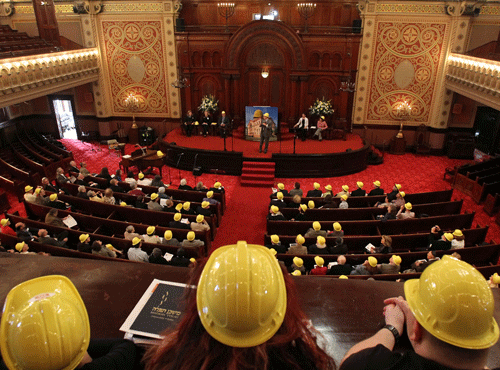TAKE A LAST LOOK at the majestic pink temple glowing in the late afternoon sunlight at the corner of California and Webster.
It is quickly being enveloped by scaffolding for a seismic retrofit that will strengthen the hundred-year-old home of Congregation Sherith Israel. And it will lose its distinctive salmon pink paint job and emerge next year in its original gray-green color of unpainted Colusa sandstone.
Through ingenious engineering, the unreinforced masonry building will otherwise look much as it always has. The walls will be strengthened through an approach called center coring, leaving the architecture intact. The interior — an artistic treasure of painted frescoes, stenciled walls, stained glass windows and hand-carved mahogany furnishings — will be unchanged.
The temple was completed only a few months before the 1906 earthquake, but suffered little damage. It was also mostly undamaged by the 1989 quake, but seismic standards have since been strengthened and public use of the building has been limited in recent years while a renovation plan was devised and funded.
The retrofitting project was launched at a Hard Hat Shabbat service on Friday, April 16. Construction began the following Monday, a day after the anniversary of the 1906 quake.
“Our challenge was to identify the structural things about the building that made it work well during the 1906 quake,” says Terry Paret, one of the project engineers. “The marks left by the earthquake are still there, and we can learn from them.”
The solution — to reinforce the building by drilling through the brick and stone walls to add steel rods and grout — will not compromise the design by Albert Pissis, one of San Francisco’s great early architects, who also designed the Emporium, the Flood Building and the Mechanics Institute.
Pissis also designed the medical library on the same block at Webster and Sacramento, which is also built of Colusa sandstone. The library has never been painted, and gives a good idea of how the temple will look once it is stripped of the pink paint added in the 1950s.
“The paint has done more harm than good,” says Craig Etlin, vice president of Sherith Israel. Moisture trapped under the paint damaged the surface. In recent years, scaffolding was required over the surrounding sidewalks to protect passersby.
EARLIER: “Scaffolding is only the start“
Filed under: Landmarks






